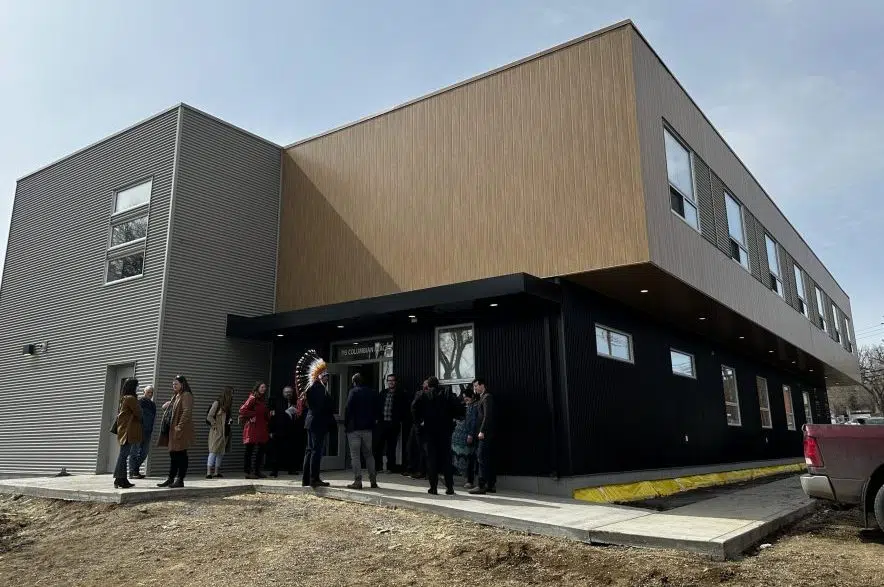Women being released from jail in Saskatchewan now have a new place to call home.
On Friday, the Saskatoon Tribal Council opened Īkwēskīcik iskwēwak – which means “turning your life around” – in collaboration with different levels of government. The halfway house is serving as a transition for women leaving the Pine Grove Correctional Centre and returning to society.
“So now they have a place to finish off their sentence,” said Tribal Chief Mark Arcand.
“They can actually come here for a maximum of 18 months.”
The brand-new facility will be staffed 24 hours, and has a shared laundry facility. Otherwise, the women have their own private spaces. Each suite is furnished with a bed, table and chairs, and is equipped with a kitchen and a bathroom.
Six women will move into the home on Monday. The remaining 12 will come soon after, based on a waiting list of 100 eligible women at Pine Grove.
The tribal council received $3.8 million from the Rapid Housing Initiative in the National Housing Strategy in the fall of 2021, which was used to build the 18 housing units located at 115 Columbian Place in Saskatoon.
According to Arcand, Pine Grove case plans and assessments will determine whether or not women will be admitted to the facility after being released.
“The thing(s) we are noticing when we go meet with the women is we have a quick turnaround time because it’s an Indigenous organization dealing with Indigenous people.” Arcand said. “We see and we understand the situations that are happening, so for us it is really making a quick impact.”

STC chief Mark Arcand and Saskatoon Mayor Charlie Clark share a handshake on April 14, 2023. (Dulce Abela/650 CKOM)
He added that the tribal council is making sure that they can provide assistance, regardless of the situation. That can include rehabilitation, mental health and addictions support, and access to psychologists and elders.
“It’s wide open to whatever they need,” Arcand said.
Saskatoon Mayor Charlie Clark called it “chilling” to speak with inmates and learn their biggest concerns are about being released — and being set up to fail without a plan in place to help them with housing and work support once they leave prison.
Clark said the project brought together federal and provincial support, and required the city to figure out how to meet such a significant need.
The completion of the home is the final project in the Pleasant Hill area, Clark said, marking the end of a 15-year effort to build a village in the neighborhood. Hilary Gough, city councillor for Saskatoon’s Ward 2, worked hard to see the project through, Clark shared.
The hope for the space, Clark said, is to protect the next Kimberly Squirrel. She was a 34-year-old woman who died three days after she was released from Pine Grove Correctional Centre last January.
Clark said the program “is going to save lives and make a difference” by fighting the crisis of homelessness and addiction Saskatoon is currently facing.
Arcand echoed that sentiment, applauding the collaboration between the federal and provincial governments and other organizations to see the project completed.
He said the project is about helping people and making a difference in the lives of others.
“This is what it takes to work together,” he said.
Arcand said the number of people’s lives that have been impacted by prison — beyond just those incarcerated — is “unacceptable.”
Pam Damoff, MP for the Ontario riding of Oakville North—Burlington, acknowledged that policies of the Canadian government and colonization have directly resulted in high incarceration rates among Indigenous people.
She said women need support to prevent them from entering the criminal justice system in the first place. Without help, Dumoff said women are being set up to fail.
“What you’re doing here will save lives,” she said of the new home.
Housewarming gifts — dreamcatchers and an original piece of artwork called “Building Futures” by Cree-Ojibwe artist Simone McLeod — were presented at the grand opening on Friday by Ian Carlson with 3twenty Modular, a contractor involved in the building of the home.
Drew Wilby, assistant deputy minister for corrections, policing and public safety, called it “incredible” to see the collaboration that went into the building of the women’s home.
He said his department noted the women’s prison population was spiking — an increase of 200 per cent entering corrections facilities throughout 2014, he shared.
“We knew we had to do something different,” Wilby said.
An investment of $1.2 million annually is being made by the province to help with operational costs.
He said the current population at Pine Grove, the only women’s correctional facility in the province, is about 200. This new home will serve women who have been sentenced, and make up about 30 per cent of that population.
–With files from Dulce Abela.











